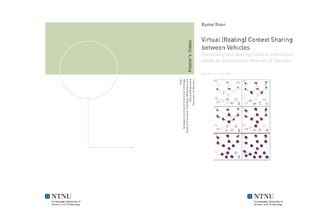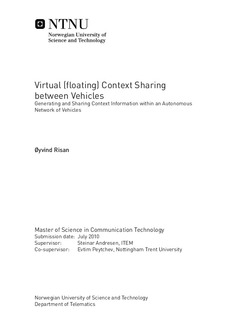| dc.contributor.advisor | Andresen, Steinar | nb_NO |
| dc.contributor.advisor | Peytchev, Evtim | nb_NO |
| dc.contributor.author | Risan, Øyvind | nb_NO |
| dc.date.accessioned | 2014-12-19T14:13:58Z | |
| dc.date.available | 2014-12-19T14:13:58Z | |
| dc.date.created | 2010-11-10 | nb_NO |
| dc.date.issued | 2010 | nb_NO |
| dc.identifier | 369190 | nb_NO |
| dc.identifier | ntnudaim:5648 | nb_NO |
| dc.identifier.uri | http://hdl.handle.net/11250/262355 | |
| dc.description.abstract | This thesis investigates some of the potential within Intelligent Transportation Systems and Inter-Vehicle Communication. The aim is to find a method for spreading information throughout an ad hoc network of vehicles with as little impact on the available resources as possible.Two problems are identified and investigated. The first problem is determining the border of a known set of vehicle positions. This is solved by producing a list of edges that encircles vehicles which contain the same information. These edges form a border that can be used to reduce the amount of data needed to represent the status in that particular area. By reducing the amount of data the load on the limited transmission capacity can be reduced.Based on mathematical calculations relating to the relative position of vehicles, an algorithm was devised to detect and order the vehicles that contribute to the border of an area. It is possible to alter the shape of the border by removing selected points on the border. This makes it possible to make the border convex instead of concave. The behaviour of this border finding algorithm is illustrated by a java program. The graphical representation also displays some of the mechanisms used to determine the border.The second problem is related to how information can be distributed efficiently to all vehicles within a network. As there are limited capacities in most vehicle-to-vehicle-networks there is a need to focus on reducing the overall load in such networks. The aim is to distribute the available information to every vehicle in the network as efficiently as possible, without acting at the expense of speed and flexibility.The choice of information exchange method has a serious effect on the transmission load, and the amount of interference that is present in the network. Pure flooding is the most basic and elementary of the methods available. The two main strengths of this method are the reactive behaviour, and the ability to adapt to any network configuration.This thesis suggests an alternative method for broadcasting information throughout the network, without having to use pure flooding . The method is called ICE ( Information Combined and Exchanged ). This method collects the available data and aggregates this to one single new message. To do this a delay is introduced between a vehicle receiving a message and retransmitting it. All messages received during this time are included in the following transmission.ICE does not limit what kind of information that could be exchanged, but examples of useful information might be warnings, points of interest, infotainment and advertisements.Based upon the behaviour of ICE a simulator was made to test the performance. The simulator made it possible to compare the performance of both ICE and pure flooding by measuring various variables. The main parameters were the size of the introduced delay and the number of vehicles in the simulation area. The combinations of the parameters and broadcast methods lead to 96 simulations from which a great amount of information could be extracted.The results showed that ICE outperformed pure flooding with regards to transmission load, interference and lost messages. At selected delays the time each vehicle is involved in the communication is also superior to pure flooding .The most significant findings are: ICE generally performs at its best with a delay of about 50 ms Any individual vehicle s involvement time might be reduced by as much as 74% Depending on the number of unique messages the number of sent messages can be reduced by 77% to 86% The interference can on average be reduced by 66% Pure flooding is outperformed by ICE in almost all the situations that were tested in the simulator in this thesis. A situation with very sparsely populated networks and long delays is the exception. In this case pure flooding is faster, but might waste more resources. Implementation of dynamic delays would make ICE suitable for this scenario as well. | nb_NO |
| dc.language | eng | nb_NO |
| dc.publisher | Institutt for telematikk | nb_NO |
| dc.subject | ntnudaim:5648 | no_NO |
| dc.subject | SIE7 kommunikasjonsteknologi | no_NO |
| dc.subject | Nett og tjenestekvalitet | no_NO |
| dc.title | Virtual (floating) Context Sharing between Vehicles: Generating and Sharing Context Information within an Autonomous Network of Vehicles | nb_NO |
| dc.type | Master thesis | nb_NO |
| dc.source.pagenumber | 111 | nb_NO |
| dc.contributor.department | Norges teknisk-naturvitenskapelige universitet, Fakultet for informasjonsteknologi, matematikk og elektroteknikk, Institutt for telematikk | nb_NO |

